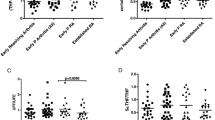Abstract
In healthy individuals measures of 11β-hydroxysteroid dehydrogenase type 1 (11β-HSD1) enzyme activity predict the change in bone formation markers in response to therapeutic glucocorticoids. It is unclear whether these measures remain predictive in inflammatory disease. We therefore examined whether 11β-HSD1 activity predicts changes in bone markers and bone mineral density (BMD) in patients with inflammatory bowel disease (IBD) treated with therapeutic glucocorticoids. Prospective and cross-sectional studies were carried out in patients attending a gastroenterology clinic with active (n = 39) or clinically inactive (n = 34) IBD and healthy controls (n = 51). Urinary corticosteroid metabolite profiles were obtained on a spot urine sample and total corticosteroid metabolite excretion and 11β-HSD1 activity (measured as the ratio of tetrahydrocortisol to tetrahydrocortisone metabolites, [THF+alloTHF]/THE) determined. Patients with active disease were treated with an 8-week reducing course of oral prednisolone. The (THF+alloTHF)/THE ratio was significantly increased in patients with IBD, even those in clinical remission. The baseline (THF+alloTHF)/THE ratio failed to predict the decrease in bone formation markers or hip BMD. Measures of 11β-HSD activity do not predict bone loss during glucocorticoid treatment of active IBD, probably due to disease-related increases in 11β-HSD1 activity. Our observation of elevated 11β-HSD1 activity in clinically inactive IBD implicates gastrointestinal glucocorticoid activation in the maintenance of disease remission.



Similar content being viewed by others
References
van Staa TP, Leufkens HG, Abenhaim L, Zhang B, Cooper C (2000) Use of oral corticosteroids and risk of fractures. J Bone Miner Res 15:993–1000
Cooper MS (2004) Sensitivity of bone to glucocorticoids. Clin Sci (Lond) 107:111–123
Cooper MS, Walker EA, Bland R, Fraser WD, Hewison M, Stewart PM (2000) Expression and functional consequences of 11β-hydroxysteroid dehydrogenase activity in human bone. Bone 27:375–381
Tomlinson JW, Walker EA, Bujalska IJ, Draper N, Lavery GG, Cooper MS, Hewison M, Stewart PM (2004) 11β-Hydroxysteroid dehydrogenase type 1: a tissue-specific regulator of glucocorticoid response. Endocr Rev 25:831–866
Cooper MS, Rabbitt EH, Goddard PE, Bartlett WA, Hewison M, Stewart PM (2002) Osteoblastic 11β hydroxysteroid dehydrogenase type 1 activity increases with age and glucocorticoid exposure. J Bone Miner Res 17:979–986
Cooper MS, Blumsohn A, Goddard PE, Bartlett WA, Shackleton CH, Eastell R, Hewison M, Stewart PM (2003) 11β-Hydroxysteroid dehydrogenase type 1 activity predicts the effects of glucocorticoids on bone. J Clin Endocrinol Metab 88:3874–3877
Chapman KE, Coutinho AE, Gray M, Gilmour JS, Savill JS, Seckl JR (2009) The role and regulation of 11beta-hydroxysteroid dehydrogenase type 1 in the inflammatory response. Mol Cell Endocrinol 301:123–131
Kriel MH, Tobias JH, Creed TJ, Lockett M, Linehan J, Bell A, Przemioslo R, Smithson JE, Brooklyn TN, Fraser WD, Probert CS (2010) Use of risedronate to prevent bone loss following a single course of glucocorticoids: findings from a proof-of-concept study in inflammatory bowel disease. Osteoporos Int 21:507–513
Tobias JH, Sasi MR, Greenwood R, Probert CS (2004) Rapid hip bone loss in active Crohn’s disease patients receiving short-term corticosteroid therapy. Aliment Pharmacol Ther 20:951–957
Hardy R, Rabbitt EH, Filer A, Emery P, Hewison M, Stewart PM, Gittoes NJ, Buckley CD, Raza K, Cooper MS (2008) Local and systemic glucocorticoid metabolism in inflammatory arthritis. Ann Rheum Dis 67:1204–1210
Bryndova J, Zbankova S, Kment M, Pacha J (2004) Colitis up-regulates local glucocorticoid activation and down-regulates inactivation in colonic tissue. Scand J Gastroenterol 39:549–553
Stegk JP, Ebert B, Martin HJ, Maser E (2009) Expression profiles of human 11beta-hydroxysteroid dehydrogenases type 1 and type 2 in inflammatory bowel diseases. Mol Cell Endocrinol 301:104–108
Zbankova S, Bryndova J, Leden P, Kment M, Svec A, Pacha J (2007) 11beta-Hydroxysteroid dehydrogenase 1 and 2 expression in colon from patients with ulcerative colitis. J Gastroenterol Hepatol 22:1019–1023
Palermo M, Shackleton CH, Mantero F, Stewart PM (1996) Urinary free cortisone and the assessment of 11β-hydroxysteroid dehydrogenase activity in man. Clin Endocrinol (Oxf) 45:605–611
Cooper MS, Bujalska I, Rabbitt E, Walker EA, Bland R, Sheppard MC, Hewison M, Stewart PM (2001) Modulation of 11β-hydroxysteroid dehydrogenase isozymes by proinflammatory cytokines in osteoblasts: an autocrine switch from glucocorticoid inactivation to activation. J Bone Miner Res 16:1037–1044
Tomlinson JW, Moore J, Cooper MS, Bujalska I, Shahmanesh M, Burt C, Strain A, Hewison M, Stewart PM (2001) Regulation of expression of 11β-hydroxysteroid dehydrogenase type 1 in adipose tissue: tissue-specific induction by cytokines. Endocrinology 142:1982–1989
Hardy RS, Filer A, Cooper MS, Parsonage G, Raza K, Hardie DL, Rabbitt EH, Stewart PM, Buckley CD, Hewison M (2006) Differential expression, function and response to inflammatory stimuli of 11β-hydroxysteroid dehydrogenase type 1 in human fibroblasts: a mechanism for tissue-specific regulation of inflammation. Arthritis Res Ther 8:R108
Straub RH, Vogl D, Gross V, Lang B, Scholmerich J, Andus T (1998) Association of humoral markers of inflammation and dehydroepiandrosterone sulfate or cortisol serum levels in patients with chronic inflammatory bowel disease. Am J Gastroenterol 93:2197–2202
Cooper MS, Stewart PM (2009) 11Beta-hydroxysteroid dehydrogenase type 1 and its role in the hypothalamus–pituitary–adrenal axis, metabolic syndrome, and inflammation. J Clin Endocrinol Metab 94:4645–4654
Sylvester FA, Wyzga N, Hyams JS, Davis PM, Lerer T, Vance K, Hawker G, Griffiths AM (2007) Natural history of bone metabolism and bone mineral density in children with inflammatory bowel disease. Inflamm Bowel Dis 13:42–50
Acknowledgement
We thank the patients and volunteers who participated in the study and Proctor and Gamble Pharmaceuticals for funding this work.
Author information
Authors and Affiliations
Corresponding author
Additional information
The authors have stated that they have no conflict of interest.
Rights and permissions
About this article
Cite this article
Cooper, M.S., Kriel, H., Sayers, A. et al. Can 11β-Hydroxysteroid Dehydrogenase Activity Predict the Sensitivity of Bone to Therapeutic Glucocorticoids in Inflammatory Bowel Disease?. Calcif Tissue Int 89, 246–251 (2011). https://doi.org/10.1007/s00223-011-9512-2
Received:
Accepted:
Published:
Issue Date:
DOI: https://doi.org/10.1007/s00223-011-9512-2




